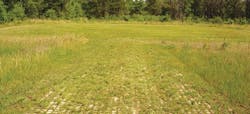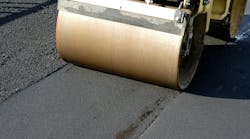About the author:
Berena Peña is with Soil Retention. Peña can be reached at [email protected] or 760.966.6090.
Fort McCoy, an active U.S. Army installation, is located on 60,000 acres between Sparta and Tomah, Wis., in Monroe County. Since its creation in 1909, it has been used primarily as a military training center.
Brooks Lundeen, the Land Rehabilitation and Maintenance (LRAM) coordinator for the Integrated Training Area Management program for Fort McCoy, wanted a drivable grass material that could support equipment to facilitate training or emergency services in the area. The main purpose was to provide landing and pick up zones for rotary aircrafts on the North and South Post of Fort McCoy.
While attending a conference, Lundeen heard about a permeable grass pavement product that compared to having a concrete driveway, without the bother of maintenance or some of the environmental concerns, and he decided to learn more.
Grass Pavers as LID
Under the new Section 438 of the Energy Independence and Security Act of 2007, federal agencies have new requirements to reduce storm water runoff from federal development and redevelopment projects to protect water resources. Agencies can comply by using storm water management practices that are referred to as “green infrastructure” or “low impact development” (LID) practices, e.g., reducing impervious surfaces or using vegetative practices and porous pavements.
Storm water is of concern for two main reasons: because of the volume and timing of runoff water (flood control and water supplies), and because of the potential contaminants that the water may carry. Water runoff not only contributes to flooding and erosion; it also plays a part in the contamination of water supply, oceans, streams and lakes. The goal should be to control storm water at the source, reduce runoff and improve water quality by filtering pollutants such as oil, gas and pesticide residue, into the substrata layers.
Although some porous paving materials appear nearly indistinguishable from nonporous materials, their environmental effects are quite different. Grass pavers allow storm water to move through the surface; in addition to reducing runoff, this effectively traps suspended solids and filters pollutants from the water. This can eliminate the need for storm drains, plastic boxes and conventional detention basins, offering a real cost value to projects.
Grass pavers can be used in place of poured concrete and asphalt and for a variety of applications, including roads, paths, lawns, parking areas, boat ramps, culvert outlets, slope armor, trickle channels and stream bank installation.
The compression strength of grass pavement systems differs according to the manufacturer. The average compression strength is 5,000 psi for concrete products.
There are various of types of grass pavers available. The flexible concrete mat can flex and conform to irregular ground surface contours and allows heavy loads without cracking. Even when saturated, the mat maintains the load-supporting characteristics. There also are concrete grid slab, plastic geocells and concrete grid paving units.
Deciding on the best type of grass paver for a project depends on its load-supporting characteristics, durability, ease of installation and how well the root system is developed underneath the paver.
Fort McCoy’s Success
The LRAM crew at Fort McCoy installed the grass pavers in 2009. The pavers were filled with topsoil, and left to sit over the winter. Then, in 2010, grass seed from a variety of short grasses such as June Grass, San Drop Seed and White Clover were broadcast over the grass pavers.
Lundeen said the drivable grass areas at Fort McCoy have been mowed only once a season.
“It looks aesthetically pleasing and has held up quite well,” Lundeen said. “We’re looking to do more areas like this to support training.”
Download: Here


